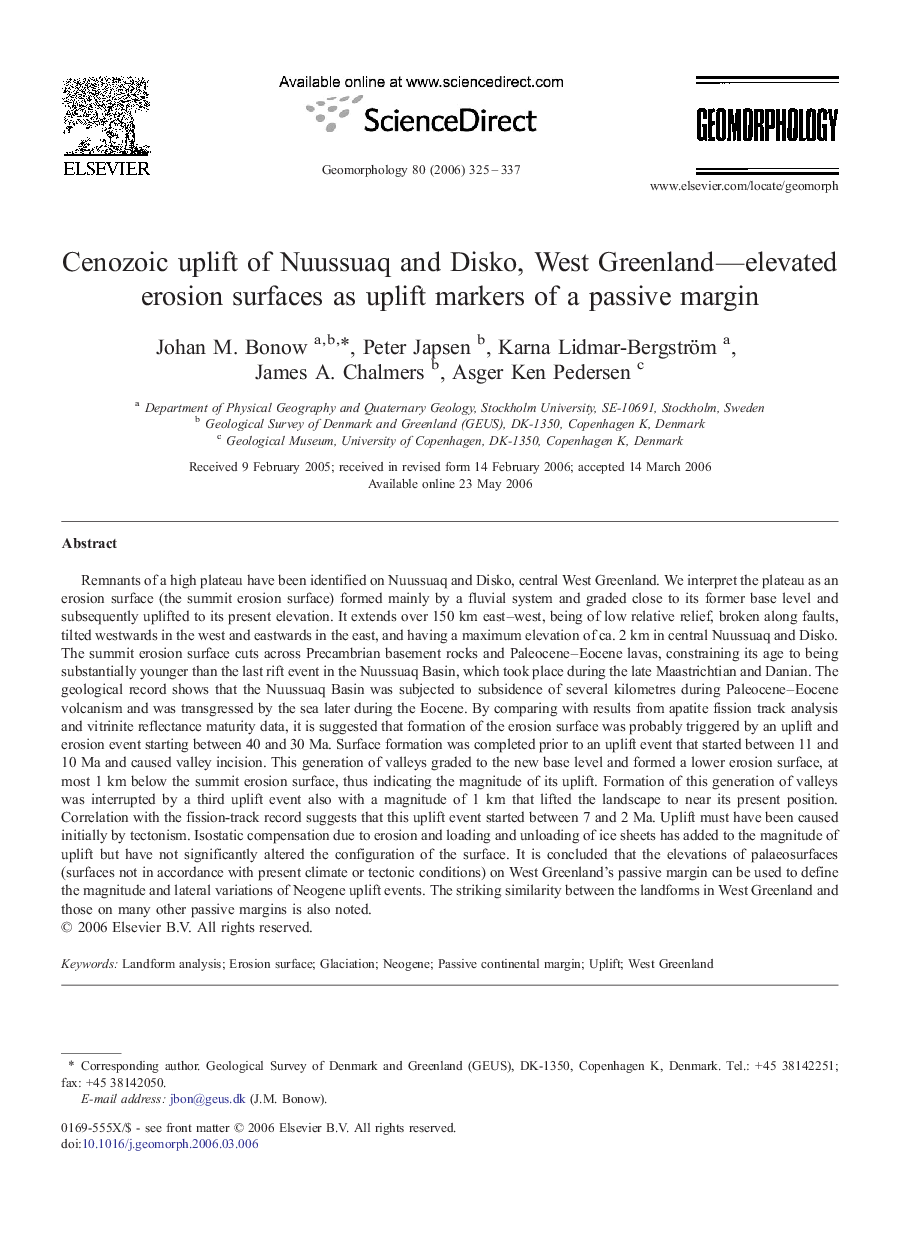| کد مقاله | کد نشریه | سال انتشار | مقاله انگلیسی | نسخه تمام متن |
|---|---|---|---|---|
| 4687421 | 1635591 | 2006 | 13 صفحه PDF | دانلود رایگان |
عنوان انگلیسی مقاله ISI
Cenozoic uplift of Nuussuaq and Disko, West Greenland-elevated erosion surfaces as uplift markers of a passive margin
دانلود مقاله + سفارش ترجمه
دانلود مقاله ISI انگلیسی
رایگان برای ایرانیان
کلمات کلیدی
موضوعات مرتبط
مهندسی و علوم پایه
علوم زمین و سیارات
فرآیندهای سطح زمین
پیش نمایش صفحه اول مقاله

چکیده انگلیسی
Remnants of a high plateau have been identified on Nuussuaq and Disko, central West Greenland. We interpret the plateau as an erosion surface (the summit erosion surface) formed mainly by a fluvial system and graded close to its former base level and subsequently uplifted to its present elevation. It extends over 150Â km east-west, being of low relative relief, broken along faults, tilted westwards in the west and eastwards in the east, and having a maximum elevation of ca. 2Â km in central Nuussuaq and Disko. The summit erosion surface cuts across Precambrian basement rocks and Paleocene-Eocene lavas, constraining its age to being substantially younger than the last rift event in the Nuussuaq Basin, which took place during the late Maastrichtian and Danian. The geological record shows that the Nuussuaq Basin was subjected to subsidence of several kilometres during Paleocene-Eocene volcanism and was transgressed by the sea later during the Eocene. By comparing with results from apatite fission track analysis and vitrinite reflectance maturity data, it is suggested that formation of the erosion surface was probably triggered by an uplift and erosion event starting between 40 and 30Â Ma. Surface formation was completed prior to an uplift event that started between 11 and 10Â Ma and caused valley incision. This generation of valleys graded to the new base level and formed a lower erosion surface, at most 1Â km below the summit erosion surface, thus indicating the magnitude of its uplift. Formation of this generation of valleys was interrupted by a third uplift event also with a magnitude of 1Â km that lifted the landscape to near its present position. Correlation with the fission-track record suggests that this uplift event started between 7 and 2Â Ma. Uplift must have been caused initially by tectonism. Isostatic compensation due to erosion and loading and unloading of ice sheets has added to the magnitude of uplift but have not significantly altered the configuration of the surface. It is concluded that the elevations of palaeosurfaces (surfaces not in accordance with present climate or tectonic conditions) on West Greenland's passive margin can be used to define the magnitude and lateral variations of Neogene uplift events. The striking similarity between the landforms in West Greenland and those on many other passive margins is also noted.
ناشر
Database: Elsevier - ScienceDirect (ساینس دایرکت)
Journal: Geomorphology - Volume 80, Issues 3â4, 30 October 2006, Pages 325-337
Journal: Geomorphology - Volume 80, Issues 3â4, 30 October 2006, Pages 325-337
نویسندگان
Johan M. Bonow, Peter Japsen, Karna Lidmar-Bergström, James A. Chalmers, Asger Ken Pedersen,